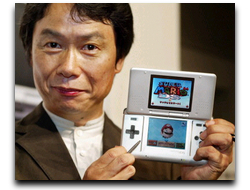 Miyamoto said Nintendo used E3 as a platform for spreading the word to a broad audience based on the media present at the event, they’re not speaking to the core audience. So, if you’re a core audience gamer and you were confused on why Nintendo didn’t build their presentation to be all glitz and glamor, it’s because they weren’t talking to you.
Miyamoto said Nintendo used E3 as a platform for spreading the word to a broad audience based on the media present at the event, they’re not speaking to the core audience. So, if you’re a core audience gamer and you were confused on why Nintendo didn’t build their presentation to be all glitz and glamor, it’s because they weren’t talking to you.
Based on the fact that E3 is a “press event” and their looking to get out the word to the general audience, press is needed as a staging point. The audience sitting in the seat was a bit more intense in nature and have high expectations for each presentation.
With sites like gamespot streaming the event live on the Internet it’s not too hard to imagine some casual gamers and non-core-gamers may have been listening. Or, perhaps their hoping to get old school media in the form of magazines and journalists to write about their upcoming product launches.
Or, perhaps they just showed up because they’re expected to?
(Thanks, Joystiq)
